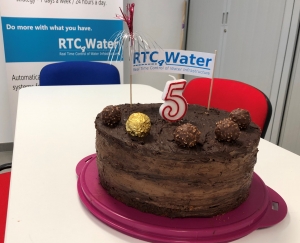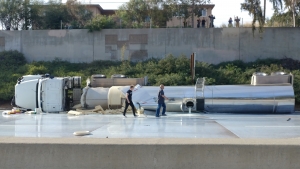Our Latest Achievements and Developments
Water management is an ever-evolving field, and our team at RTC4Water is at the forefront of the latest developments.
We are proud to announce our recent successes, which showcase our dedication to finding innovative solutions to the challenges faced in this field.
Firstly, we are delighted to share that our joint application with the University of Luxembourg to the FNR for an Industrial Fellowship has been approved!
This achievement is a testament to the hard work and collaboration of our team, and we extend our gratitude to everyone who contributed to this success.
We would like to give a special thank you to Rodrigo Gesser, who took the lead in writing the proposal.
We are excited to continue our research in the areas of water and wastewater with this support.
In addition, we have made significant progress in optimizing sewage overflows during rain events with our product, LINKWATER.
While our VOLUME-based system is already highly effective, we identified a remaining problem with this methodology: it is possible to have a small sewer overflow with a high concentration into a small river on one side of the sewer system, while on the other side, a large volume with a low concentration is "successfully" prevented from overflowing. To address this, we have developed a prototype product that minimizes the LOAD going to the river during a rain event, which has shown promising results in initial simulations. Our PhD student, Rodrigo Gesser, played a key role in this development, and we extend our thanks to him.
Finally, we are excited to attend IFAT, where we will showcase our latest developments, including load-based control and our new water quality module.
We welcome you to visit us at the stands of our partners, Rittmeyer and DHI, and see these innovations in action.
At RTC4Water, we remain committed to pushing the boundaries of water management and developing solutions that benefit both our clients and the environment.
Stay tuned for more exciting updates from our team. #Water #wastewater #sewer
Happy Birthday RTC4Water! And GPC version 4.1 is just in time for the party!
Today is the 5-year anniversary of RTC4Water and what a 5 years it has been! The company started with 3 employees and only a few contracts to supply an early Global Predictive Controller (GPC) to the Luxembourgish market. Today we are installing intelligent controllers that will, by 2024, control the water distribution networks of at least 70% of all communes in Luxembourg!
Last week we launched a software update (version 4.1) of the GPC, which now has its own OPC-UA server - meaning that multiple GPCs can now securely communicate and share data with a central server and/or with each other! This is very exiting (yes really!) and allows us to solve issues where, for example, several communes are taking water from a single supply line that has become too small due of our exploding population in Luxembourg. These GPCs can now tell each other how “stressed” each network is for water and they can now cooperate and make sure that all communes get enough. GPC 4.1 also comes with an enhanced remote monitoring system (called Chloé) to supplement our 7/7 global checking, monitoring and leak detection systems so that our clients are always sure that their systems are performing day and night.
As always, we greatly appreciate the support that we get from our clients and partners. Without them, our goal of developing the most advanced, fully autonomous network optimization software would not be possible.
Water Network Supply Autonomy: How Real-time, Autonomous Network Optimization Can Provide Critical Support During Emergency Events
It is never the most important topic when we meet with clients. In fact, it is a topic that almost never comes up – at first. But as the central focus of our work involves optimizing resources within a water network, eventually the subject of water supply autonomy makes its way into the conversation. “What can be done within my network if my water source becomes compromised?”. Or, put a different way, “How much autonomy can I get from my network given the water I already have in my basins?”
Give Yourself Time to Find the Best Solution
Correctly evaluating the scope and scale of a supply problem is always the first step that an administrator or engineer must perform. In many cases, notification about a pollution event comes too late and the solutions like trucking in clean water from another source, distributing bottled water or proclaiming so called “boiling orders” become the only options. But in situations where a supplier can identify a problem before it gets into a specific network, or if one key source becomes unavailable due to drought or mechanical failures, then what? Is there a way to “stretch out” the water currently in storage and gain more time to remedy the situation?
Automation of your Network: Where do You Stand?
Automation impacts all industries and many actors in the water and sewer domain are now beginning to embrace solutions that bring new levels of efficiency. While the benefits of an automatic pilot in an airplane or an industrial robot to assist assembly workers on an assembly line are well understood, in the water sector the widespread use of autonomous and intelligent systems are still in their infancy. Many administrators appreciate the ability to manually view and adjust their network activity via the information and alerts provided by advanced SCADA systems. This is a natural first step toward improved efficiency and should be encouraged; especially for those networks that are still operating with mechanical floater-valves or with hardware with limited digital capabilities. But what is the argument for continuous, autonomous optimization? Water engineers are highly trained and paid to keep their networks operating based on their experience as well as their local knowledge. It is their job to both monitor and make corrections as needed.
Network Optimization Can Make More of a Difference Than You Think
In our experience, and this has been reinforced time and again based on our discussions with clients in other countries and at trade fairs, most network administrators have at least one component of their network that they would like to fully automate. Everyone seems to have a least one operational challenge; perhaps it is the one basin in your network that serves a very demanding client. Maybe it is managing stand times more efficiently so that your engineers can focus on finding and fixing leaks. Or perhaps you have tried to hire someone to perform advanced programming for one of your PLC controllers and the results were far from perfect. And now, to add to the problem, there is an additional layer of complexity that needs to be accounted for during an emergency or unplanned maintenance event. If you look at these one or two items individually, then they are manageable and can typically be handled manually. But it is only when we take a holistic look at the overall efficiency of a network, specifically during a drought or an emergency, that the benefits of autonomous network automation become apparent.
Three Examples Dealing with Network Automation and Security of Supply
In order to make a more compelling case for automation in the water industry, we would like to present two use cases developed from working with our clients and one that is more hypothetical. This first case is one that is familiar to almost all administrators; a fire event occurring at night.
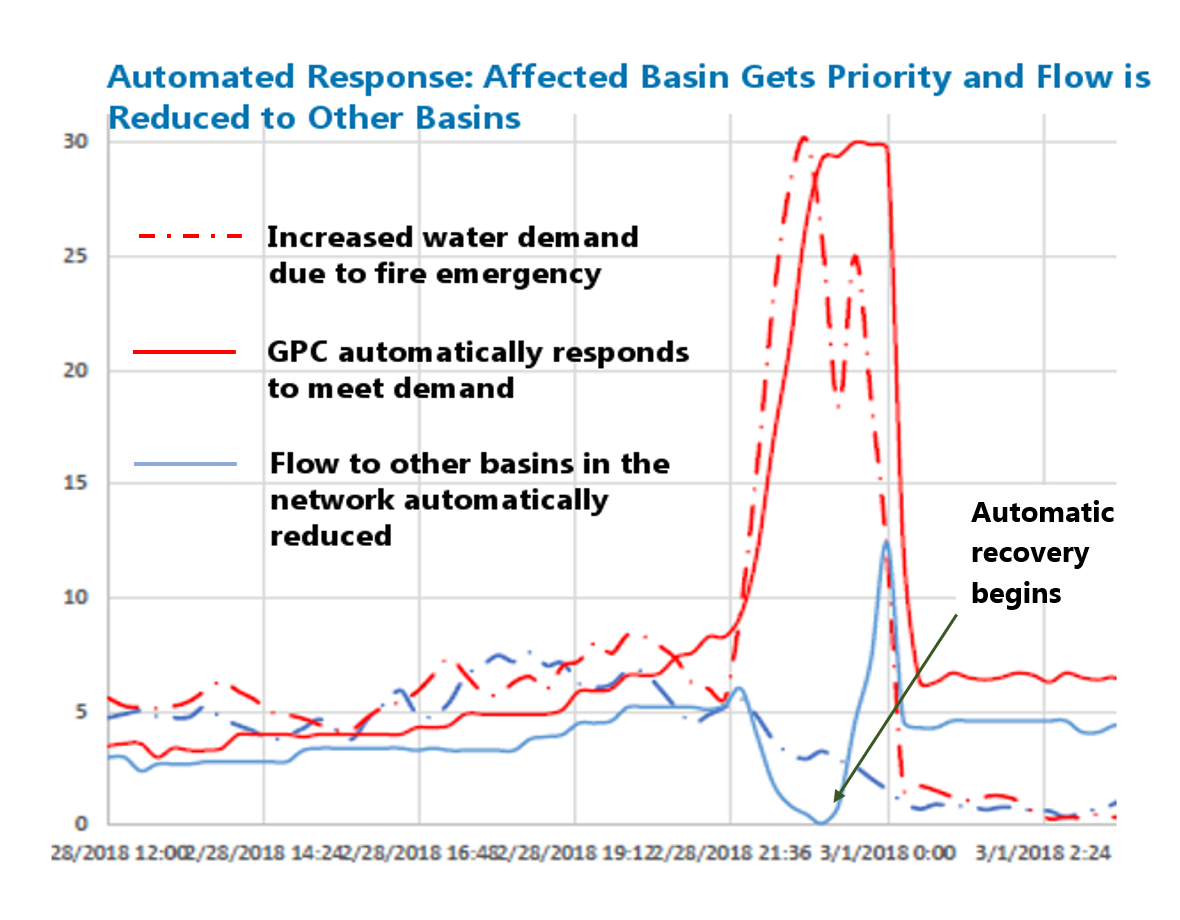
In this example, our automated and predictive software – the Global Predictive Controller, or GPC for short – has detected an increase in demand in one basin that is out of standard. In this case, it automatically adapted by doing two things at the same time: first, the system matched the demand for water and kept the basin from reaching its minimum level. Then, because this client wants to minimize the amount of water purchased from his supplier, demand was reduced to other basins. And because the GPC uses predictive algorithms to anticipate future demand, the system then automatically began to return the network to its normal operating state once the fire event was over. No engineers were needed to monitor or react to this event. The GPC detected the change within 15 minutes of it occurring – because it monitors flow and basin capacity – and then automatically began to return all basins to normal, pre-planned capacity once demand returned to normal.
The second example deals with a situation where there are competing inflows from one supply-line into several basins. This may result in situations where one or more basins are starved of water while another, usually geographically lower positioned, basin is filling. In principal, a loss of supply might occur if this remains unnoticed or remedial actions are not performed in a timely manner. Below is a graph showing how an automated solution would manage this scenario.
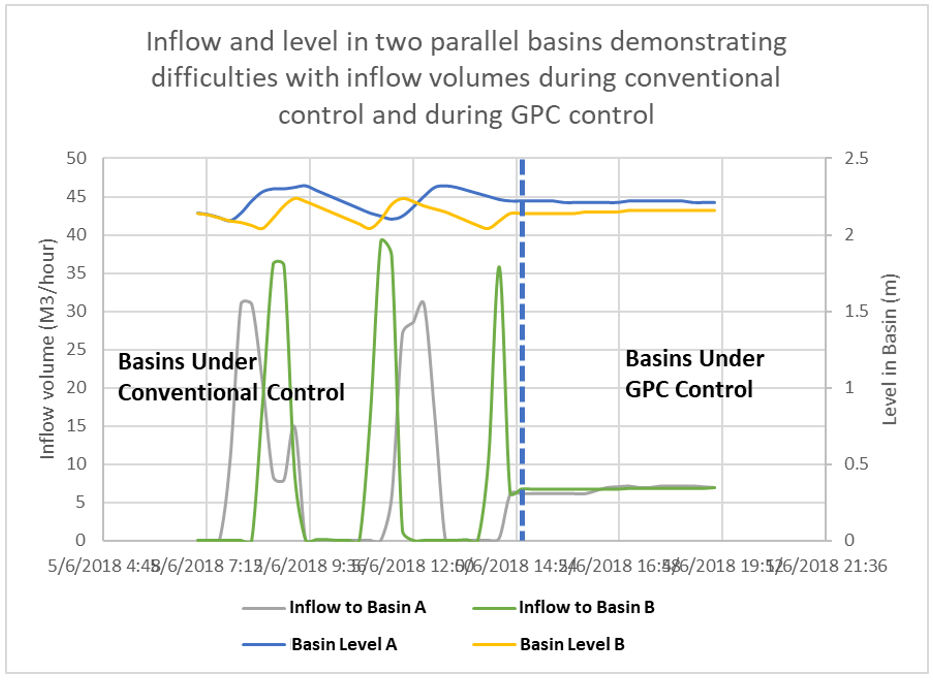
Finally, our last example is a modelled scenario demonstrating how network autonomy can be extended when the supply becomes compromised (like in a pollution or drought event) and the amount of water available for use is drastically reduced. By using an automated and predictive approach, the supply can be maintained much longer by more efficiently distributing the available water (in this example from 5 to 8 days) giving network administrator has more time to take remedial action or organize emergency supplies. If you have a question about the information provided above or would just like to share a situation where automation helped your organization, please feel free to contact us at info(at)rtc4water.com.
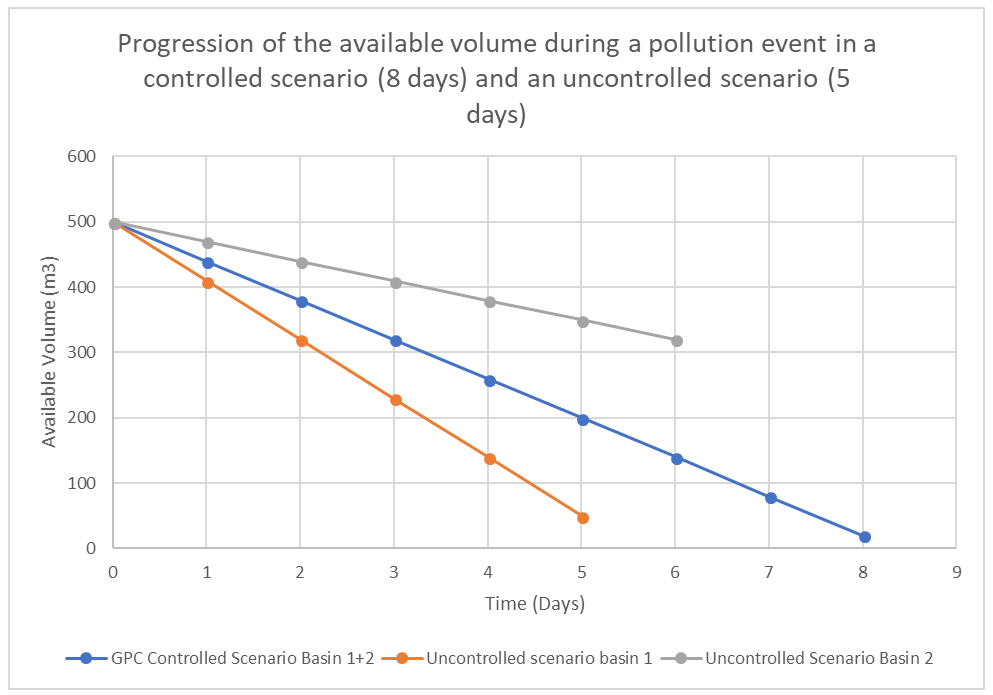
In conclusion, we encourage network administrators and engineers to take a more holistic approach to automation within their network. While a product may be purchased to solve one specific type of problem, the advantages that automation can provide are usually more widespread.







